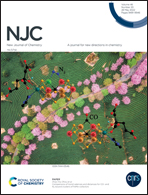Quasi-anisotropic benefits in electrospun nickel–cobalt–manganese oxide nano-octahedron as anode for lithium-ion batteries†
Abstract
Despite having a significantly higher capacity (>1000 mA h g−1) as compared to the conventional graphite anode, the adoption of the conversion-type transition metal oxide (TMO) anodes is restricted due to their inferior cycling stability, sluggish ion transport behavior, high potential plateau vs. Li/Li+, etc. Subsequent developments through nanostructuring and chemical composition engineering have improved the electrochemical performance of TMO anodes. Herein, a quasi-anisotropic nano-octahedron quaternary metal oxide composite is designed and synthesized using pilot-scale electrospinning by manipulating the conductivity of the polymeric solution. This morphology is first reported via electrospinning, which routinely produces nanofiber morphology. The fabricated nano-octahedron exhibited slightly higher gravimetry specific capacity (∼1184 mA h g−1 at 100 mA g−1) as compared to the nanofiber counterpart (1075 mA h g−1 at 100 mA g−1), with an initial capacity loss of 37.4% and 38.7%, respectively. Owing to the isotropic volume expansion, the nano-octahedron was capable of retaining 78.9% (or 291.2 mA h g−1) capacity after 500 charge/discharge cycles at 1000 mA g−1, compared to the inferior 24.1% (or 71.1 mA h g−1) for its nanofiber counterpart. Overall, the results discussed here provide valuable information on morphology design for future high-performance TMO anodes.



 Please wait while we load your content...
Please wait while we load your content...